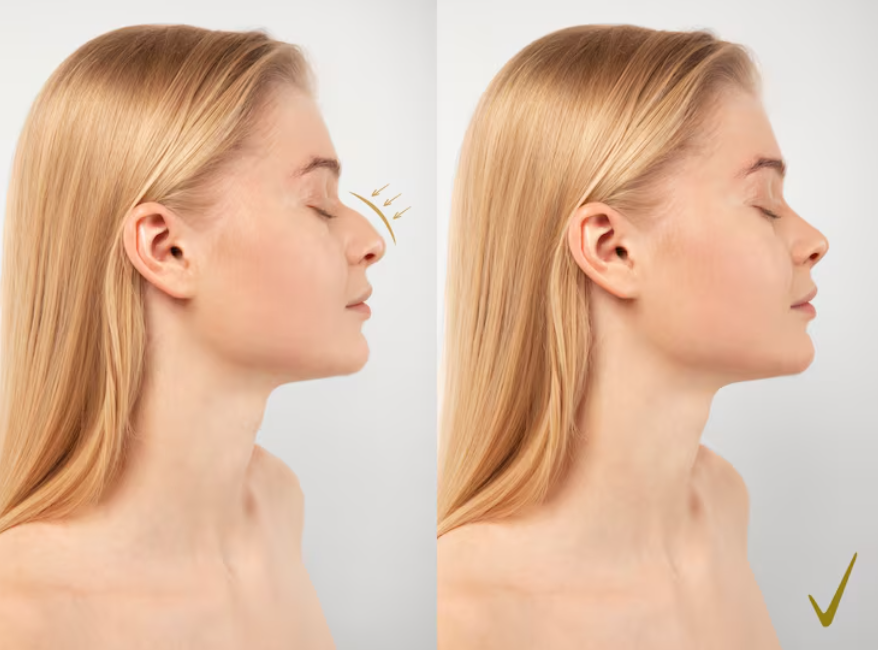Treatment Overview
Bridge Height Enhancement Ethnic Rhinoplasty in Korea is a specialized nose surgery designed to raise and define the nasal bridge while maintaining the natural balance of ethnic features. Many ethnic groups—including Asian, African, Hispanic, and Middle Eastern patients—tend to have a lower nasal bridge, which can make the nose appear flatter or less defined in profile.
Korean plastic surgeons are globally recognized for their expertise in ethnic rhinoplasty, offering advanced techniques such as cartilage grafting, silicone or Gore-Tex implants, and autologous tissue augmentation. The goal is to achieve a natural, refined, and proportionate nasal bridge that enhances overall facial harmony without erasing ethnic identity.
Purpose & Benefits
- Increases bridge height and definition for improved facial profile.
- Creates better balance between the nose, forehead, and chin.
- Enhances nose projection while preserving ethnic features.
- Provides a more sculpted and refined appearance.
- Corrects asymmetry or congenital flatness of the nasal bridge.
- Boosts self-confidence through improved aesthetics.
Ideal Candidates
This procedure is suitable for individuals who:
- Have a naturally low or flat nasal bridge.
- Desire more definition and contour without looking unnatural.
- Want to refine their nose while preserving ethnic identity.
- Previously underwent augmentation but are unsatisfied with results.
- Are in good health and have realistic expectations.
Possible Risks & Complications
While surgery in Korea is generally safe, possible risks include:
- Swelling and bruising (temporary).
- Implant shifting or extrusion (rare with skilled surgeons).
- Infection or delayed healing.
- Over-augmentation leading to unnatural results.
- Scar tissue formation or need for revision.
Surgical Techniques Used
Korean surgeons use a tailored approach depending on patient anatomy and preference:
- Silicone or Gore-Tex Implant Augmentation – Provides a defined, stable nasal bridge.
- Autologous Cartilage Grafting – Uses septal, ear, or rib cartilage for natural enhancement.
- Fascia or Dermis Grafting – Soft-tissue support for subtle and natural projection.
- Hybrid Techniques – Combining implants with cartilage grafts for long-lasting stability.
- Osteotomy (if needed) – Reshaping nasal bones for symmetry and alignment.
Recovery & Aftercare
- Downtime: 7–10 days before returning to daily activities.
- Swelling & Bruising: Improves within 2–3 weeks; final results visible after 3–6 months.
- Clinic Aftercare in Korea: Specialized treatments like anti-swelling therapy, LED light care, and scar prevention programs.
- Follow-Up: Regular post-op check-ups ensure long-term stability and natural healing.
Results & Longevity
Bridge height enhancement provides long-lasting, often permanent results, especially with cartilage grafting. Implant-based augmentation also offers durable outcomes when performed by skilled Korean surgeons. Results are designed to look natural and ethnically harmonious, avoiding an artificial or “Westernized” appearance.
Treatment Process in Korea
1. Consultation
- 3D imaging and profile analysis.
- Discussion of bridge height, implant vs. graft preference, and natural balance.
2. Pre-Surgery
- Medical evaluation and customized surgical planning.
3. Surgery
- Performed under general or local anesthesia with sedation.
- Procedure time: 1–2 hours depending on complexity.
4. Immediate Recovery
- Nose splint applied for stabilization.
- Swelling minimized with cold compresses and clinic care.
5. Follow-Up & Aftercare
- Stitches and splints removed in 5–7 days.
- Continuous aftercare available for international patients.
Why Korea?
- Ethnic Expertise: Korean surgeons are highly trained in respecting and enhancing ethnic features.
- Advanced Techniques: Use of cutting-edge implant materials and cartilage grafting methods.
- Natural Results: Focus on subtle enhancement rather than over-augmentation.
- Comprehensive Care: Clinics offer translation, recovery facilities, and post-op monitoring.
- Global Recognition: Korea is a world leader in rhinoplasty medical tourism.
Cost Range
The cost of Bridge Height Enhancement Ethnic Rhinoplasty in Korea varies depending on materials and surgical complexity:
- Implant Augmentation (Silicone/Gore-Tex): ₩4,000,000 – ₩7,000,000 KRW ($3,200 – $5,600 USD)
- Cartilage Grafting (Septal, Ear, or Rib): ₩6,000,000 – ₩12,000,000 KRW ($4,800 – $9,600 USD)
- Hybrid Techniques: ₩7,000,000 – ₩13,000,000 KRW ($5,600 – $10,400 USD)
Additional costs may apply for osteotomy or revision surgery.
Popular Clinics
- ID Hospital (Seoul): Specializes in natural-looking bridge enhancement.
- Banobagi Plastic Surgery: Known for advanced ethnic rhinoplasty techniques.
- JW Plastic Surgery Clinic: Expertise in cartilage grafting and hybrid augmentation.
- View Plastic Surgery: Offers 3D imaging-based nose design.
- MINE Plastic Surgery: Popular among international patients for natural, harmonious results.




